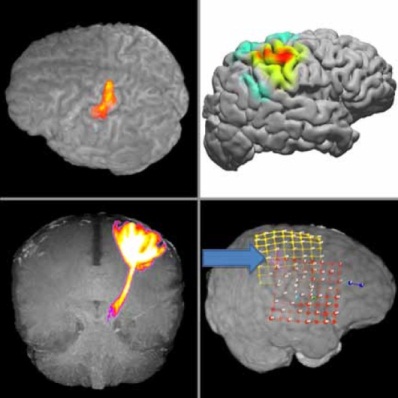Scientists at the Center on Human Development and Disability (IDDRC) at the University of Washington Health Sciences Center Work to Unravel the Puzzle of Epilepsy
Modern medical science, including researchers affiliated with the Center on Human Development and Disability (CHDD), has made significant strides in understanding some of the causes of and in treating epilepsy. Using new imaging techniques that enable them to study the brain at the molecular level, researchers such as Edward J. Novotny, M.D., a University of Washington professor of neurology and pediatrics, expect even greater progress in the years ahead.
Unraveling the Puzzle of Epilepsy
by Joel Schwarz
Edward Novotny uses a variety of imaging modalities to pinpoint such actions as hand function in the brains of young patients who have epilepsy. Pictured clockwise at the upper left is an image using fMRI co-registered with MRI; the upper right image was made by high frequency EEG signal; the lower right image was made by an intracranial EEG recording with electrodes superimposed over fMRI with the arrow pointing to hand function; and the lower left image used diffuse tractography of the corticospinal tracts, bundles of axons that stretch between the cerebral cortex and the spinal cord.
Although the ancient Greeks knew about it nearly 2,500 years ago, epilepsy remains a puzzling and curious disorder. This is partly because epilepsy is not a single disorder, but a syndrome encompassing more than 40 disorders characterized by episodic abnormal brain activity. However, modern medical science, including researchers affiliated with the Center on Human Development and Disability (CHDD), has made significant strides in understanding some of the causes of and in treating epilepsy. Using new imaging techniques that enable them to study the brain at the molecular level, researchers such as Edward J. Novotny, M.D., a University of Washington professor of neurology and pediatrics, expect even greater progress in the years ahead. Recent advances include breakthroughs in understanding normal brain development, discovering some of the genes that are responsible for causing many types of epilepsy, and in the timing of surgery to treat certain forms of epilepsy, said Novotny, who also is the head of the epilepsy program at Seattle Children's Hospital.

To help unravel the puzzle of epilepsy Novotny is involved in a wide-ranging research agenda focusing on the electrophysiology of the disorders. This work includes gathering and creating a data bank of patient information about epilepsy so that clinicians eventually may be able to predict seizures, using a Wii-like game to noninvasively identify the localization of specific functions in a child's brain and looking for phenotypic markers for epilepsy by exploring the differences in how various brain networks are connected in children with epilepsy compared to typically developing individuals. Novotny's work centers on pediatric epilepsy, as well as in creating an interdisciplinary approach to understanding and treating it and other neurological problems.
The prevalence of epilepsy is estimated to be between 2 and 3 percent of the population and the disorders are most common in childhood, from infancy through late adolescence, and in those 65 years of age and older. Over a person's lifetime, one in 10 people will have an epileptic seizure. While about 70 percent of children with epilepsy will eventually outgrow it, early identification and treatment is important. "Many forms of childhood epilepsy are genetic. Early treatment is critical because with a genetic disorder such as epilepsy there is a lot of comorbidity with a range of other cognitive disorders stretching from autism to more subtle conditions. One of the most important things we can do is to identify the specific variety, or phenotype, of epilepsy a child has. This means identifying the behavior and the seizure type because that is critical in treatment," Novotny said. It also is important to determine the impact seizures are having on a child's brain function. Absence seizures, for example, can happen dozens, even hundred, of times daily and this can have a major impact on a child's memory and attention. Other children have a risk of death from seizures. There are some genes that are expressed in both the brain and in the heart and in rare disorders this can lead to sudden unexplained death in epilepsy.
A good portion of Novotny's research focuses on exploring the link between seizure location and brain function in epilepsy and functional connectivity in the brain. For example, Novotny recently used functional magnetic resonance imaging (fMRI) to look at functional connectivity in young epilepsy patients and age-match control subjects while their brains were in a resting state during an eight-minute scan. The work showed that there are well-defined brain regions that are connected, but that these systems are connected differently in children with genetic epilepsy than in youngsters who are developing typically. "By being able to separate one form of epilepsy from another and identifying networks and systems, such as working memory, that are impacted by epilepsy, we may be able to identify problems before they occur and provide intervention," he said. What makes determining seizure location and brain function in children even more complicated is the fact that the relationship between the two is different in children than in adults.
Novotny also is involved in exploring the use of non-invasive techniques to pinpoint the location of seizures. He used data collected from non-invasive evoked potentials and electroencephalography, as well as information from invasive direct brain stimulation, to locate hand motor function in an adolescent prior to surgery. The data were collected while the patient used a computer program analogous to playing a game on a Wii, a computer game system, which monitored finger movements. "This allowed us to perform surgery on the patient without damaging a critical area because we were able to identify the source of the seizures," he said.
Novotny also hopes to launch trials later this year on two devices for treating some forms of childhood epilepsy based on treatments developed for Parkinson's disease and Tourette's syndrome. He is awaiting approval to conduct what would be the first trials of this type in treating pediatric epilepsy. One device is known as a deep brain stimulator and is currently being used extensively in Parkinson's and other movement disorders while the second is called a responsive neurostimulator. Novotny believes these devices likely will be applied as treatment for different types of epilepsy. He is also continuing work with former colleagues at Yale University in building an epilepsy data bank with the intent of finding algorithms that may predict seizures. In addition, Novotny is exploring the use of a procedure called tractography to obtain very fine two-and three-dimensional images of the brain. Tractography uses magnetic resonance imaging and computer-based image analysis to produce images showing how various cortical and subcortical regions are linked together in networks. Novotny also is involved in the Epilepsy Phenome/Genome Project, a study funded by the National Institute for Neurological Disorders and Stroke, to identify genes that influence the development of epilepsy and those that affect responses to treatment.
Novotny's overall research is based on creating an interdisciplinary approach to investigating neurological problems. "I interact with investigators from the CHDD, Department of Radiology, Children's Hospital, Children's Health Research Institute, the College of Engineering and the Integrated Brain Imaging Center. Many of the tools I use can be expanded to other neurological disorders. I want to work with people at the basic science level and I'm looking to work with faculty to build bridges among these disciplines. There still can be dramatic improvements in treating epilepsy and overall cognitive performance. Drugs for epilepsy just treat symptoms, but imaging advances can lead to curative treatment in the future."
You can find this article in pdf form for download at http://depts.washington.edu/chdd/outlook/CHDD_Outlook_2011_1.pdf. For more information, please send an email to [email protected].
Last Edited: 04/01/11 12:47 PM by Corina Miclea







